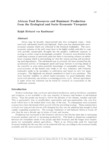Africa may be broadly characterized into five ecological zones ; Arid, semi-arid, sub-humid, humid and highland. Each zone has characteristic socioeconomic systems which are reflected in the livestock husbandry. The socioeconomic systems of the arid zones have to be highly mobile and able to cope with periodic catastrophic droughts but the people's traditional response of moving to wetter zones is increasingly curtailed. Livestock were dominat in the traditional systems of semi-arid zones but there is increasing reliance on subsistence cropping which is encroaching on vital dry season grazing and accelerating land degradation. The sub-humid zone is currently the least stressed but the accelerated activity of immigrant small and large farmers is moving ahead of the scientific or even ethno-scientific knowledge of sustainable systems. The socio-economy of the humid zone tends to be very sedentary and livestock husbandry tends to be secondary to cultivation and based on very low input strategies. The highlands are densely populated so land is at a premium. The farm families' inability to afford inputs necessary for good husbandry when faced with adversity can initiate a worsening poverty cycle. African agriculture is under stress but solutions can be found by research on components of the traditional systems.

